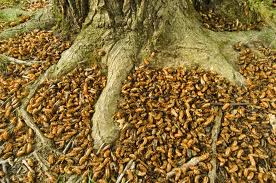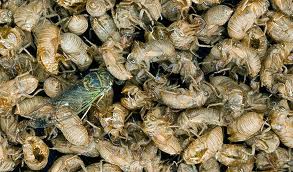Cicadas: Number Theorists of the Insect World
When I was a young, awkward pre-teen growing up in Cincinnati, with a bad haircut and an ill-advised choice of clarinet in the school band, I got to witness one of nature’s reminders that she still exists, even in suburbia — the emergence of the 17-year cicada. Every 17 years, literally millions of these harmless insects squirm out of the ground and throw one massive insectoid block party for four to six weeks. If you’re in certain parts of the midwest or east coast in the right year, your late-spring hobbies will include sweeping empty cicada shells off your driveway and sticking your fingers in your ears to avoid the deafening noise.
These guys are completely harmless — they don’t sting, bite, lay eggs in your forehead, or disturb your credit rating. They hardly do anything while above ground, and in fact can barely be bothered to move out of your way. Emerging from the ground starts the final phase in their lives, as they mate, lay eggs, and die within weeks. The eggs hatch larvae, which promptly disappear below ground for another 17 years. Despite their harmless nature, the sheer amount of them is undeniably creepy — it really reaches biblical-plague levels of sheer thundering bugg-age.
This is probably creepy enough for those of you who have never heard of these things — “oo, an article about bugs! And what makes these bugs special? There’s lots and lots and lots of them!! Great!!! Somebody lend me an ax, I’m going to delete this webpage the hard way!” But it gets even creepier. I personally witnessed the ’87 hatchling, so I made my zen-like peace with them. What really creeps me out, now that I’ve done the minimal amount of research you have come to expect from this website, is that my belief about how they spend their below-ground time is wrong. I held the delusion that their 17-year subterranean stretch was some kind of hibernation, that they didn’t “wake up” until squirming out to the air. Nope — the horrible truth is that they tunnel around, eating and moving and squirming, millions and millions of them, squirming and squirming under our feet EVERY DAY. For this information you can thank (or curse) Dr. Gene Kritsky, a nationally-recognized cicada expert at the College of Mount Saint Joseph in Cincinnati. When not squirming, they suck nutrients from the roots of trees, and in fact you can see the resulting stress on trees in the months before and after an emergence.
So why am I bringing this up, besides the fact that if I have to be creeped out by them, so do you? Well, it has to do with the number of years that go by between infestations — 17 years. Why is a 17-year cycle so odd? First of all, that is a hell of a long time. What other insects do you know that live 17 years? How does the cicada manage to live long enough to be able to take a driving test, when most other insects wouldn’t live long enough to finish reading this article? Even more odd — how did these cicadas decide on 17, which is a prime number? Other cicada broods come up every 13 years, another prime number. How on earth does a bug without the mental firepower to avoid getting eaten figure out how to set its alarm for a prime number of years?
Prime numbers are of course the crack cocaine of the mathematical world. For centuries they have been causing great excitement among mathematicicans and other assorted nerds, eliciting beads of perspiration to roll down their short-sleeved dress shirts and sock ties. A prime number is a number, like 17, or 5, or 11, or 9,999,991, that you can’t divide evenly by any other smaller number. It’s a pretty simple idea to describe, but very quickly prime numbers prove to be one of the really strange and unexplainable features of math. Lots of number theorists spend their lives exploring the properties of prime numbers and trying to pick up any underlying patterns in them. I would have done the same, if I hadn’t been so busy captain-ing the football team and hanging out at raves. At the same time. While playing a guitar solo. So how does a little bug know what a prime number is, and why would it choose one (and a pretty large one at that) for its life cycle?
The answer may have ultimately to do with not getting eaten. You may hate math, and you may have already stopped reading this once you saw “prime numbers”, but if your life depended on your knowledge of math, you better believe you’d be putting on the sock tie right quick. As is proved time and time again in nature, any little quirk or adjustment you can make as a species to reduce your chances of being eaten helps, and over millions of years, will be put to good use. Think of the zebra’s stripes, peacock feathers, or Jimmy Fallon’s hair — no matter how strange the feature, if it helps the propagation of the species it will be put to use.
So what is it about prime numbers that help the lowly cicada avoid getting eaten? There are a few plausible theories out there, but no one knows for sure. (Imagine the practical problems of doing experiments on something that arrives once every 17 years — “What do you mean, I missed them? I was at sock-tie camp!”) There’s at least a plausible reason why they only come up for air all at the same time. Emerging from the ground in one giant group essentially gives the predators too much to eat, so the chances of any one Cicada getting eaten are lower. If there are literally millions of the guys flying around, with no defenses, no evasive manuvers, practically covered in barbecue sauce, then the predators will get their fill quickly. The birds, lizards, and three-year-old humans will eat what they can, but they’ll make barely a dent in the giant swarm of Cicadas that appear aboveground. So the Cicadas have decided on the “safety in numbers” strategy.
So, then, why the prime-number cycle? The best guesses at the moment suggest that using a prime-number cycle makes it hard for a predator to guess the arrival time of the cicada buffet. If you’re an insect species, and you alternate your life between above and below-ground, eventually your predators will learn to stop looking around for you while you’re munching on the roots. The predators might even learn to live on the same kind of cycle themselves, maybe even hibernating until you emerge again. In the ever-escalating Arms Race Of Bugs, you might decide to delay coming out of the ground to every other year, to throw the predators for a loop. Maybe it will be harder for the predators to come find you, if you only show up half the time. And if it’s harder for a predator to find dinner that only shows up every other year, imagine how hard it would be to wait around for seventeen years!
And if you set the alarm for a prime number, it’s more unlikely that a predator will lock on to your cycle, and wait for you when you peek out of the dirt. Let’s say you decide to come up every 12 years. Well, then the Great Horned Snail, with a cycle of 2 years, will catch you every time you come up for air. So will the Green Ankled Pooping Sparrow, with a cycle of three years. And so will the Reticulated Snipe, with a cycle of 6 years. You get the idea. A cycle number with lots of divisors (like 12, 16, or other “highly composite” numbers) won’t do as well as a prime number like 17. A predator might catch you every once in a while, but they won’t be able to lock onto your cycle unless they guess your number exactly right — they can’t hope to use easy cycles like 2 or 3 or 4 years, if those numbers aren’t divisors of your cycle.
In fact, numerical simulations bear this out — Mario Markus has published work showing that for Cicada populations with randomly-chosen cycle lengths pitted against similar random-cycle predators, the variants with prime-number cycle lengths tended to survive better than others. Glenn Webb has published similar studies. In effect, their work simulates the day-to-day warfare between predators and prey, and shows that cicadas who choose prime-number cycles just happen to get eaten less. The choice of seventeen is presumably the longest prime-number length of time the Cicada could stand, within the limits of reasonable insectoid lifetimes.
Alright, so that’s a pretty clever strategy, and it seems feasible that it would help keep them Cicadas prosperous. But this doesn’t explain how the cheez-for-brains Cicada figured this out. It can’t be accomplished by one Einsteinian Cicada in one flash of brilliance (“Maybe we should also stop flying into people’s windshields”), it takes many many years of mutations that randomly change the cycle length for this to develop. Over time, the cicada families that happened to carry prime-number genes beat out the others, with the 17-year gene winning. The random mutations still occur, of course, but everyone who deviates from the 17-year plan gets promptly eaten, stamping out the mutated gene. This game even stamped out guys with the correct 17-year cycle, but the bad luck to be offset (say, by coming out of the ground three years later than the main cycle). These guys make their arrival during the “cicada drought”, so they can’t hide in the sheer numbers of their fellows to avoid being eaten. The net effect is to select for a big prime number for the cycle, and to force everyone to adhere to the same cycle.
So how do these little guys keep track of the time? Tiny calculator watches? Keith Clay, a biologist at Indiana U., has shown evidence that they may be paying attention to the natural cycles of the sap in the trees they feed on while underground, cycles caused by the seasonal growth patterns of the trees (you know, the whole dropping-leaves-in-fall thing). By “tricking” trees in the lab to follow a faster seasonal cycle, Clay and company were able to trick the cicadas to emerge early. So it appears they can somehow “taste” the arrival of summer (or at least notice a change in the sap as the seasons pass), and count how many seasonal changes go by. At the seventeenth year, they wait for spring (by waiting for the temperature to hit 64 degrees), crack open a beer, and start the month-long party.
If you’re not completely creeped out by now, allow me to hit your mental windshield with a big, fat, mosquito filled with an inexplicable amount of fluid1. The cicada invasions clearly leave the affected people with strange ideas, as recipes for eating cicadas are now commonly available. My favorite is for “Soft-Shelled Cicadas”. Don’t you wish I was still talking about windshields? Just consider this step, taken directly from the recipe:
“Marinate cidadas, alive in a sealed container, in Worcestershire sauce for several hours.”
Man! Can you believe it? Absolutely disgusting. Worcestershire sauce? That treatment is much too harsh for the delicate, subtle meat of the delicious Cicada. I guess you could say, that in the world of insectoid gastronomy, the Cicada is definitely prime!
I’m terribly sorry for that last joke.
Further Reading:
Keith Clay’s Cicada Page, Indiana University
Gene Kritsky’s Cicada Page, College of Mount St. Joseph
Cicadaville.com used to be a great spoof website, but now it looks abandoned. Maybe they’ll bring it back in seventeen years…
Glenn Webb at Vanderbilt University
Mario Markus, Max-Planck-Institut
Footnotes:
1. Don’t you hate that when that happens? Bugs you squish around the house, there’s hardly anything to them — just a couple wings, an antenna or two, maybe a leg that you can’t quite pick up in the tissue, falls behind the garbage can, and is discovered later by your horrified wife. But every so often, a bug will hit your windshield that leaves such a wet splatter that it clearly must be carrying a little tank of mosquito gatorade. It must have been heading for a mosquito football game, where it was planning to dump the gatorade tank on the mosquito coach.







 Follow Timeblimp on Twitter
Follow Timeblimp on Twitter